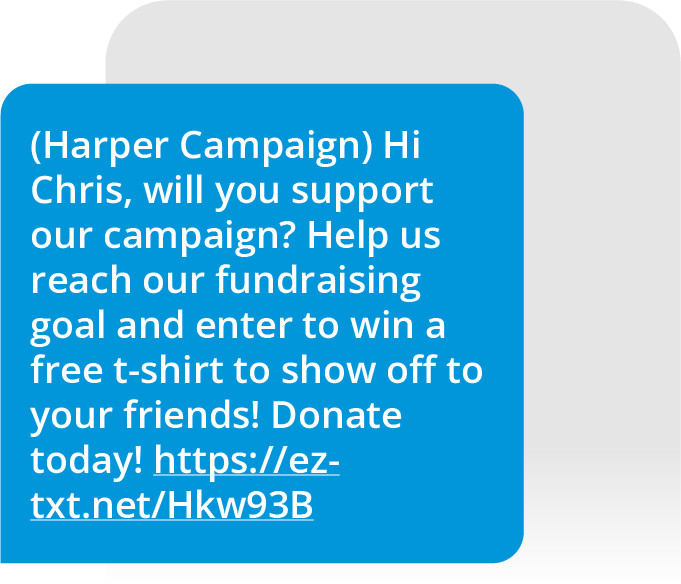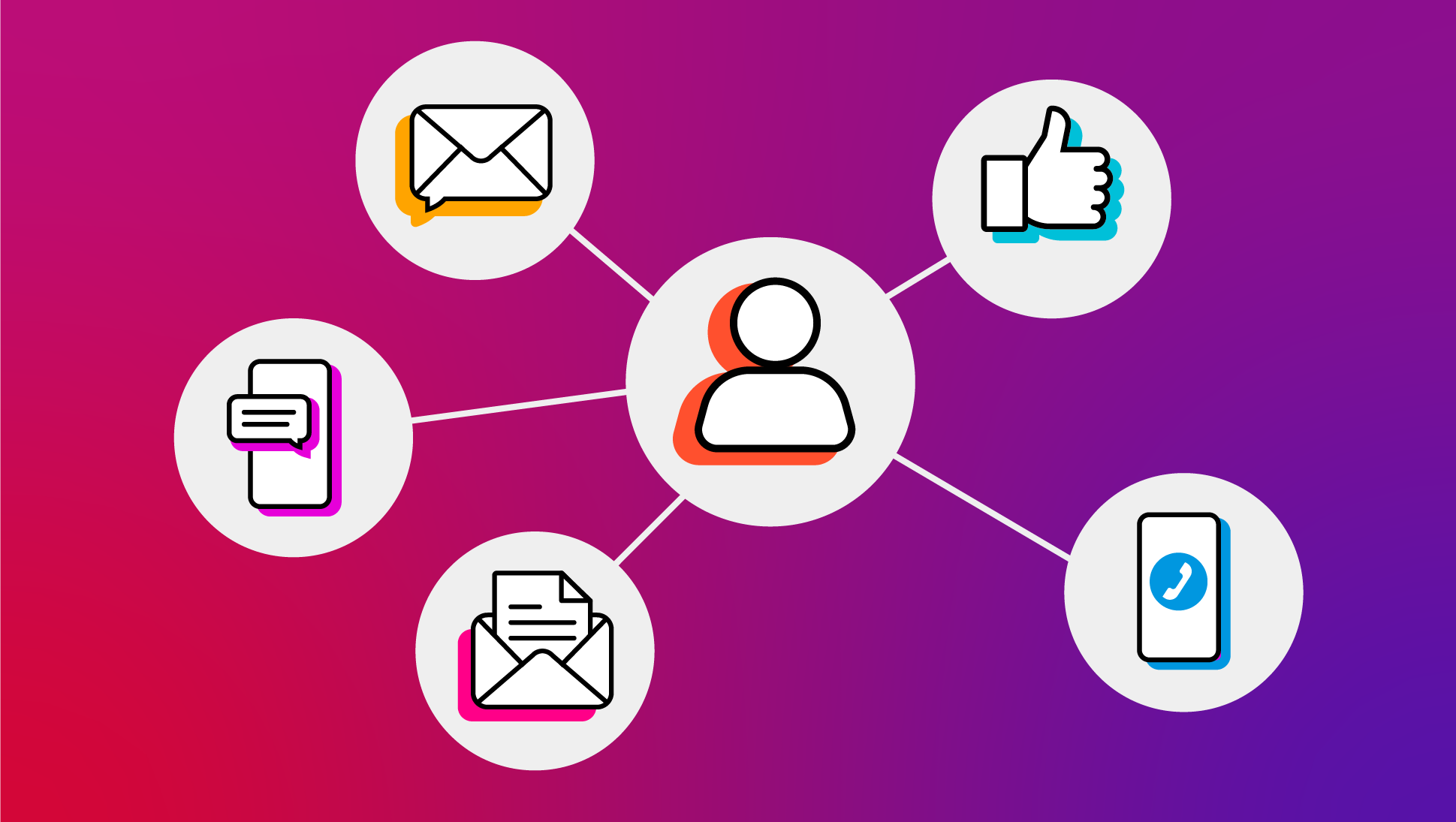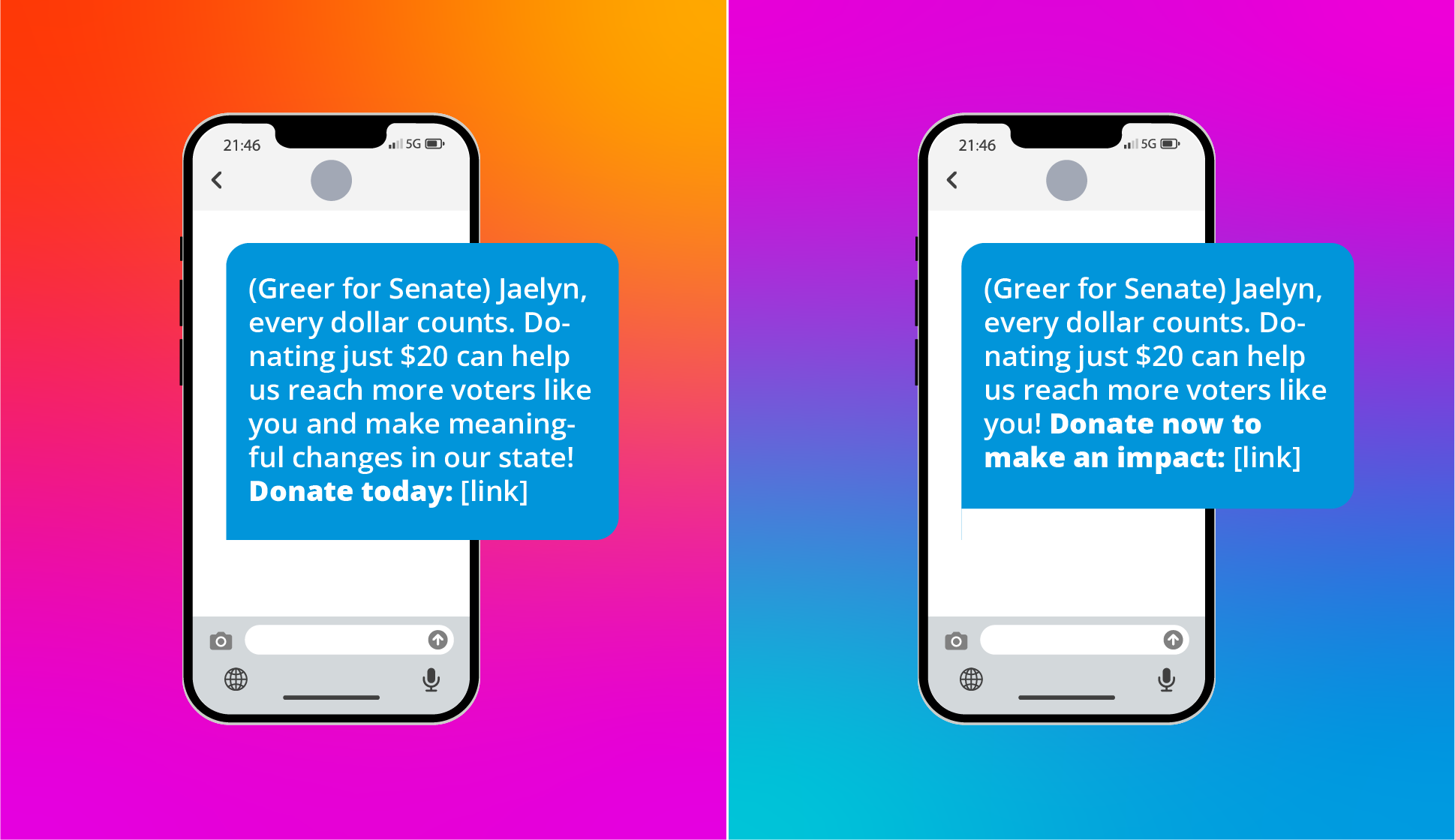How to Text Voters: Strategies that Work
Get ready to send your political campaign soaring with these top texting strategies

When you want to know how to reach voters, set your traditional campaign playbook aside and make way for SMS strategies that keep pace with today’s constantly evolving communication landscape. With this guide, you’ll learn the best tactics to text voters, ranging from the science of microtargeting to the simple art of knowing the right day of the week to send messages.
But first, let’s touch on why your political campaign should be texting people in the first place.
Why Text? Outpacing Traditional Voter Outreach
Whether you’re a communications manager for a campaign or a political organization, you probably want to know the biggest benefits of texting voters compared to other outreach methods.
The biggest benefits of texting voters compared to other outreach methods are better engagement, a wider reach, and immediacy. Let’s uncover more about each benefit.
Better Engagement
While other communication channels, like email, social media, phone calls, and door-to-door canvassing, are engaging, SMS can be even more so due to its robust capabilities. Polls and surveys, text-to-donate features, and more all allow voters to interact with your messages.
Plus, two-way texting allows your campaign to have one-on-one, personalized conversations. You might think, “Well, I can do that with phone banking or canvassing in person.” The benefit of texting is that the contact can reply or ask questions independently without feeling the pressure of a live conversation. This puts the power back into their hands, giving them another reason to respect and appreciate your campaign’s communication tactics.

Wider Reach
Political campaigns that text voters can broaden their audience reach. 96% of Americans own a phone capable of texting, meaning a huge portion of the public can engage with your political texts.
What’s more, SMS messages have a 98% open rate. This is an incredible benefit for campaigns, as emails only have an 18% open rate, and 8 in 10 Americans typically don’t answer phone calls from unknown numbers.
So, what do all these stats mean for your campaign? Your texts will reach more people.
Immediacy
Timing is everything in any marketing campaign — political campaigning included. You must reach voters at the right time and ensure that important messages are received quickly. Texting provides the immediacy you and your voters need, with most people opening their text messages within 90 seconds of receiving them. That means they can read and engage with your messages faster than they would with other channels. So, when you have unanswered phone calls or unread emails, rely on SMS texts to get your message read promptly.
SMS Voter Outreach Strategies for Success
Now that you know why political campaigns should text voters, let’s cover how to reach voters through SMS efforts. Refer to this list as you develop and maintain your campaign communication to ensure you use the right tips and tricks to engage and mobilize your audience.
Leverage Microtargeting Tactics
Mobile voter engagement strategies begin with microtargeting, gathering data, like demographics, voting behavior and tendencies, and voter preferences, to segment groups and tailor messages to each of those groups. Organizations can use microtargeting for ads, marketing, and other types of communication across all channels: email, social media, phone calls, and, of course, texting.
Political campaigns can gather information from voter data files and other compliant sources, then use data analysts and/or machine learning to produce insights into how each person or group is likely to vote, their concerns, relevant issues, etc. Text messages can then be crafted and tweaked to match the attributes of each group to engage and persuade.
You might wonder, “What are some effective ways to segment voter data for microtargeting in my SMS campaigns?” Some effective ways to segment voter data for microtargeting in your SMS campaigns include analyzing demographics, voting history, top issues, past engagement with messaging, and geographic location for personalized outreach.
Be sure that your microtargeting tactics are ethical. Only use voter data from reputable political databases that follow data privacy laws. Ensure that the information you share is factual, and don’t manipulate or deceive with your persuasive content.
Engage with Voters
Engaging your audience is crucial for every political text message campaign — because if your messages aren’t engaging, why would someone interact or keep reading?
The first step in engaging your audience is to personalize. What are some creative and engaging ways to personalize text messages for voters? Some creative and engaging ways to personalize text messages for voters include using their first name, mentioning local references, crafting the message around an issue that is important to them personally, their community, or their generation, and scheduling texts according to how they’ve interacted with your messages and campaign thus far. These are all tried-and-true methods for getting to the heart of what matters to your audience and helping them feel like more than just a ballot.
Other text voter best practices for engagement revolve around providing ways to interact with your messages. This could include sharing a poll or survey to gain valuable feedback and help their voices be heard, incorporating conversational texting to promote a more personal relationship with your campaign, and leveraging voter engagement tools like RCS messaging for a feature-rich and interactive experience.
Know Your Audience

We’ve touched lightly on the element of knowing your audience in the previous sections, but we’ll dive a bit deeper into this strategy here. While seemingly simple, knowing your audience pertains to much more than voter history, party affiliation, and other voting-specific data. When you text voters, you also need to remember your contacts’ ages, region or community in which they live, and where they are in the voting journey.
- Age: Always consider your contact’s age — because what words, phrases, and tone of voice one generation might respond to well, another might not. On top of that, each generation tends to have different issues that they care about most (like healthcare and social security for Baby Boomers). Get insights and tips into texting across generations to reach voters of all ages.
- Region/community: When you want to know how to reach voters, ensure you’re tapping into the issues and concerns relevant to where they live and considering specific state/city legislation.
- Voting journey: Your contacts are in different stages of interaction with your campaign and the election process, so ensure that your messages match where they are in their individual journeys.
So, to recap, what are some common mistakes to avoid when texting voters? Common mistakes to avoid when texting voters include not using language or tone of voice appropriate for your audience and sending messages irrelevant to their local issues and concerns and their voting journey.
Educate and Share Resources
Educating and sharing resources is one of the best mobile voter engagement strategies for all contacts, especially for swing voters or those with a history of not voting.
Many campaigns wonder, “How can I leverage text messaging to educate voters and encourage informed participation?” You can leverage text messaging to educate voters and encourage informed participation by highlighting the joy and pride of doing your civic duty. Share MMS messages with gifs or inspirational videos that remind people why their votes matter. (Hint: Depending on your audience, you can make this fun and humorous or even persuade with something like “your peers are voting in the upcoming election, so you should, too . . .”)
Second, your campaign can provide education on hot-button or locally relevant issues that some voters might not know enough about to make an informed decision. Text voters easy-to-read guides or short videos on candidates, issues, and pieces of legislation. The more they know, the more likely they are to act.
Finally, get low-propensity voters to the polls by sharing informational resources, like polling places and hours of operation, state-specific voting laws, transportation, early voting, and more. Access our guide to all things get out the vote (GOTV).
Motivate Voters to Take Action
What are some proven text voter best practices for maximizing response rates? Proven text voter best practices for maximizing response rates start with a call to action (CTA). You can send a text at the right time and with relevant content, but your audience won’t know what to do with the message without a clear CTA.

Boost voter response rates by including CTAs that clearly tell contacts what you want them to do, whether registering for an event, donating to your campaign, volunteering, learning more about a topic, or responding to a question — you get the idea. CTAs proven to work are clear and specific, short and sweet, and create a sense of urgency.
Identify Yourself
This might seem insignificant in reaching voters, but identifying yourself gives your contacts peace of mind. Plus, it’s also a legal requirement, so doing so makes your audience feel more secure and helps your campaign stay compliant.
Someone receives a text message from a short code or 10DLC number that jumps into the content without mentioning the sender's name. Will that person interact with the message or consider it spam and delete it? To increase your chances of people reading and engaging with your SMS messages, always include your name or the name of the candidate or organization.
Send Texts at the Right Time and Frequency
Hitting the sweet spot of the best time to reach voters and how often to send texts can be difficult. After all, voters have unique personal and work schedules, making it hard to know when they’ll most likely read, interact with, and/or respond to your political campaign texts. While you should be constantly monitoring your texting schedule and tweaking days/times based on opt-out and response data, here are some text voter best practices for day, time, and frequency:
- Day: Weekdays are usually the best days to reach voters, with Monday through Thursday being your best shots. These days, people are less likely to be distracted by the upcoming weekend. On that note, avoid texting voters on weekends.
- Time: Align your campaign text messages with the average work schedule. So, between 8 and 9 a.m., between 11 a.m. and 2 p.m., and between 6 and 8 p.m. During these time frames, you’ll be able to catch people outside of work hours or on a lunch break, with more time to read their messages.
- Frequency: A best practice is to aim for no more than one text per week or every other week. Though, this rule of thumb doesn’t apply to triggered messages, like donation thank-yous, registration follow-ups, and the like, which all use SMS automation.
Use Peer-to-Peer Texting
Peer-to-peer (P2P) texting is a political campaign’s secret weapon for how to reach voters. This texting method involves sending individual messages to each contact rather than automated texts or bulk messages to large groups of contacts. When campaigns text voters this way, they’re more likely to see increases in response rates and engagement, as P2P texting is more personal and conversational and helps build relationships.
The caveat with P2P messaging is that texts are sent individually, not through a text messaging service (learn more about the difference between P2P and A2P). One tip is to leverage your volunteer network with P2P texting. Encourage volunteers to text their friends and family with your campaign messaging, which will help to broaden your reach.
How Texting Fits into an Omnichannel Approach

While SMS voter messaging is key to reaching, persuading, and mobilizing voters, it’s just one piece of the political campaign pie. So, the natural next question is, “How can I use mobile voter engagement strategies beyond just texting?” You can use mobile voter engagement strategies beyond texting by leveraging multiple marketing channels to engage with your audience across all touchpoints. This is a highly effective way to reach voters because it ensures that your messaging gets across to people from different backgrounds, in various age groups, who have different preferred communication methods, and so on.
Integrate your campaign communication strategy across all channels: text, email, social media, phone banking, direct mail marketing, and digital and in-person advertisements. To create a cohesive experience for your audience, ensure graphics, design, and scheduled messaging align.
And remember to connect the channels so your voters have a seamless experience. For example, embed event registration links in social media posts or email blasts or incorporate QR codes for more resources across in-person and digital contact points.
With an omnichannel voter engagement approach, your campaign can reach more people, delight voters, and create memorable moments for them.
Measuring Your Momentum: Tracking SMS Success and Response Rates
Regardless of your mobile voter engagement strategies, it’s crucial to keep track of how your political messaging campaigns perform so that you can review and tweak them if necessary. Many campaigns wonder, “How can I measure the success of my text voter campaigns and track response rates?” You can measure the success of your text voter campaigns and track response rates using your text marketing platform’s analytics and reporting tools and other campaign tracking tools. Here’s an overview of what you should be looking for:
- Click-through rates: See how many people click your links to determine how CTAs perform and if your message is persuasive.
- Opt-out rates: Tracking opt-outs can tell you what messages aren’t working or what days/times aren’t preferred.
- Poll/survey responses: Low voter response rates to polls, surveys, or other questions might mean you must rephrase or provide a more powerful CTA.
- Fundraising goals: See how many donations were driven from text, like text-to-donate or text-to-give. Learn about other secret methods for political fundraising.
- Event RSVPs and volunteer signups: Connect event RSVPs and volunteer registration to text blasts to understand if your SMS messages are motivating.

A text voter best practice is to conduct political message testing before each SMS campaign, and if you notice that something isn’t working. A/B testing for text campaigns gives you insight into what your audience prefers — or doesn’t prefer, for that matter. Test different message formats, content, CTAs, and other elements for a while, noticing how each performs. Then, use the data to inform your next texting campaign.
Learn How EZ Texting Can Help Your Campaign
Ready to put these voter outreach strategies to work? EZ Texting can help you text voters with the right messaging at the right times and using a robust suite of SMS features.
Get started with your free trial today!
FAQs
The tools and software that can help you manage and run SMS campaigns for voter messaging are text marketing platforms. These platforms have features like bulk messaging, conversational texting, contact segmentation, analytics, and compliance tools. See how EZ Texting can help you reach your political campaign goals.
You can ensure your text messages comply with legal and ethical guidelines by familiarizing yourself with federal regulations for political text messaging, registering for A2P, and using a text messaging service with built-in compliance features. Some specific tips include obtaining opt-ins, identifying yourself, allowing recipients to opt out of your subscriber list easily, and ensuring that voter data is from a reputable source.
See other resources related to:
